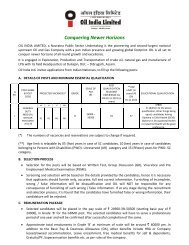Vol. 35 No. 8. May - Jun 2006 - Oil India Limited
Vol. 35 No. 8. May - Jun 2006 - Oil India Limited
Vol. 35 No. 8. May - Jun 2006 - Oil India Limited
Create successful ePaper yourself
Turn your PDF publications into a flip-book with our unique Google optimized e-Paper software.
O<br />
ne of the most important event today in the world is the<br />
spiralling price of crude oil, which has shaken the<br />
economies of many countries. <strong>India</strong> is already getting the high<br />
pinch and running helter-skelter to get a drop of oil from abroad,<br />
besides trying its best to boost indigenous exploration and<br />
production activities through different rounds of NELP. High oil<br />
prices will affect <strong>India</strong>'s economic growth very much. If the<br />
subsidies are removed and full impact of high oil prices are<br />
passed on to the <strong>India</strong>n consumers,inflation will further<br />
increase,hampering growth.<br />
Crude oil prices behave much as any other commodity with<br />
wide price swings in times of shortage or oversupply. The<br />
crude oil price cycle may extend over several years responding<br />
to changes in demand as well as OPEC and non-OPEC supply.<br />
High oil prices could result in a reduction in growth of the<br />
world's economies.<br />
In the last 30 years the significant rise in oil price was in 1979-<br />
81 when oil price rose to more than US$ 60. Reasons were<br />
the Iranian Revolution and Iran-Iraq war. The Iranian Revolution<br />
resulted in the loss of 2 to 2.5 million barrels of oil per day. At<br />
one point, production almost halted. Iraq invaded Iran in<br />
September 1980 and by <strong>No</strong>vember 1980, the combined<br />
production of both the countries was a million barrels per day,<br />
which is 6.5 million barrels per day less than a year before.<br />
Post 9/11, there is again rise in oil price and reached its peak<br />
in July <strong>2006</strong> when oil price rose to around US$ 78/ barrel.<br />
There is a prediction that oil price may reach US$ 100/barrel.<br />
Some of the various reasons, which are often cited for the<br />
recent boom in oil prices are as follows:<br />
i. PDVSA strike<br />
ii. Turmoil in the Middle East due to Iraq war<br />
iii. Boom of economies particularly in the Asian countries like<br />
iv.<br />
China and <strong>India</strong><br />
Disturbances in Niger Delta and strike by <strong>No</strong>rwegian oil<br />
workers resulting loss in production.<br />
v. Conflict between Israel and Lebanon.<br />
vi. Storing too much oil in the strategic reserves by developed<br />
countries fearing further price rise and cut off of supply.<br />
vii. Uncertainty due to USA's face-off with Iran.<br />
viii. OPEC's failure to control high oil prices.<br />
ix. <strong>Oil</strong> fuelled economic boom in Middle East.<br />
But the reasons which worries most of the geoscientific<br />
community of the world, who knows the anatomy of the oilfields<br />
from where the major chunks of oil comes from, are different.<br />
They know that the" Titans" are falling, which may have very<br />
serious and long lasting consequences in the world's<br />
economic balances.<br />
Yes, the world's last 5 super-giant fields, the" 5 Titans", which<br />
produced more than 1 million barrels per day oil at one time<br />
are declining which is of great concern for the geoscientists<br />
and more so since there is no fields which is discovered in the<br />
last 30 years which could even produce half of their peak<br />
production. And this requires serious attention by the policy<br />
makers.<br />
There are over 4,000 actively producing oil fields in the world<br />
today, which produce around 81 million barrels of oil per day<br />
from more than 1 million wells. 70% of world's daily oil supply<br />
comes from oilfields that were discovered prior to 1970. To<br />
think that most of these oil fields will still be holding the world's<br />
oil supply at a steady pace beyond 2010 could be a blunder.<br />
Out of the last 5 super-giant oil fields, the biggest one, Ghawar<br />
in Saudi Arabia was discovered in 194<strong>8.</strong> It is reported that<br />
during 1990, the field produced around 6.5 million barrels/<br />
day.(Compare this with total <strong>India</strong>'s per day production of around<br />
0.68 million barrels) Presently, the production from Ghawar<br />
has declined to 4.5 millionbarrels/ day and water percentage<br />
is increasing alarmingly.<br />
There are some reports which suggest that Samotlor oilfield<br />
of Russia, which was discovered in 1961, once produced 3,5<br />
million barrels/day and was the uncontested second supergiant<br />
ever discovered. But present production is around 0.3<br />
million barrels/day only and lost its glory of super-giant long<br />
time back.<br />
BEWARE ! THE TITANS ARE FALLING<br />
The third largest oil field, Cantarell in Mexico,<br />
was discovered in 1976 and produced at one<br />
time 2.2 million barrels/day. The present<br />
production is around 1.9 million barrels/day<br />
and declining rapidly though this is the<br />
second super-giant at present.<br />
Burgan of Kuwait, the fourth largest field of<br />
the world is the oldest of the 5 titans. It was<br />
discovered in 1938 and produced around 2<br />
million barrels/day. Presently, the production<br />
has declined to around 1.7 million barrels/day. B.N. Sarma<br />
The fifth of the super-giant, Daquing of China was discovered<br />
in 1959. It produced more than 1 million barrels/day . Presently<br />
the production is alarmingly low, less than 0..5 million barrels /day.<br />
Besides the 5 super-giants, a large proportion of the world's<br />
most important energy source, oil, comes from a small<br />
population of giant fields, around 120 of them (including<br />
Bombay High). Many of these critical fields are now very old.<br />
<strong>No</strong>t a single oilfield which produces 1million barrels/day or<br />
more. Most of the <strong>No</strong>rth Sea fields which once produced more<br />
than 400000 barrels/ day are now almost depleted. Many don't<br />
even produce 100000 barrels per day to reach the 'giant' status.<br />
After Cantarell (1976), no oil field in the world has been<br />
discovered which could produce more than 1 million barrels/<br />
day oil. In the last decade, there hasn't been a single discovery<br />
which produces more than 200,000 barrels oil per day (peak<br />
oil production expected 250,000 barrels only). In contrast, the<br />
world's 19 largest old giant fields still produce an average of<br />
over 5,00,000 barrels per day, in spite of an average age of<br />
almost 70 years, but for how long?<br />
Apart from the 5 super-giants, there are few oilfields like<br />
Prudhoe Bay in Alaska, Kirkuk and Rumailia <strong>No</strong>rth in Iraq and<br />
Safaniyah in Saudi Arabia whose peak production rose to more<br />
than 1 million barrels per day, but presently producing half<br />
than the peak production.<br />
Over the past 30 years we have developed several technologies<br />
to identify oil deposits, discovered and produced the same<br />
from places like deepwater, which was beyond reach at one<br />
time. However none matches the giants mentioned above.<br />
Despite the new discoveries, as on today, the world's oil supply<br />
is still highly dependent on relatively small number of giant oil<br />
fields discovered decades ago, whose production is declining<br />
as the fields are aging. This does not mean that the world is<br />
running out of oil. On the contrary, it underscores the need to<br />
step-up exploration activity throughout the hydrocarbon world<br />
and utilize other sources of energy also.<br />
As per OPEC, world oil demand in 2007 will reach 85.9 million<br />
barrels /day, whereas average per day production during 2005<br />
was 81 million barrels only.<br />
While search for oil and gas should continue relentlessly, <strong>India</strong><br />
should think seriously for implementing nuclear energy<br />
programme as early as possible. China is going ahead with<br />
nuclear energy programme despite acquisition of several<br />
foreign oil assets, its own extensive exploration efforts incountry<br />
for hydrocarbons and despite producing highest<br />
amount of coal and hydroelectricity in the world. We may also<br />
think seriously to utilize coal to the maximum extent possible<br />
as we have got abundant coal reserves, the 4th largest in the<br />
world and therefore is a secured source of energy. We produce<br />
only 7% of world's total coal production. Despite having a large<br />
coastline, our production from another secured source of<br />
energy, ie. wind, is only 5300 mw yearly. We are bestowed with<br />
another secured and readily available source of energy i.e.<br />
high flowing water of our rivers. We consume only 3% of world's<br />
total hydroelectricity, 4 times less than China. We do not know<br />
how much we are producing from solar energy. Thus, there is<br />
a big mismatch between abundance and utility. This gap must<br />
be reduced before it is too late. Beware! The titans are falling.<br />
(Writer is Chief Geologist working at DGH on deputation from<br />
OIL. You can reach him at birendrasarma@ yahoo.co.in)<br />
Focus<br />
13
















